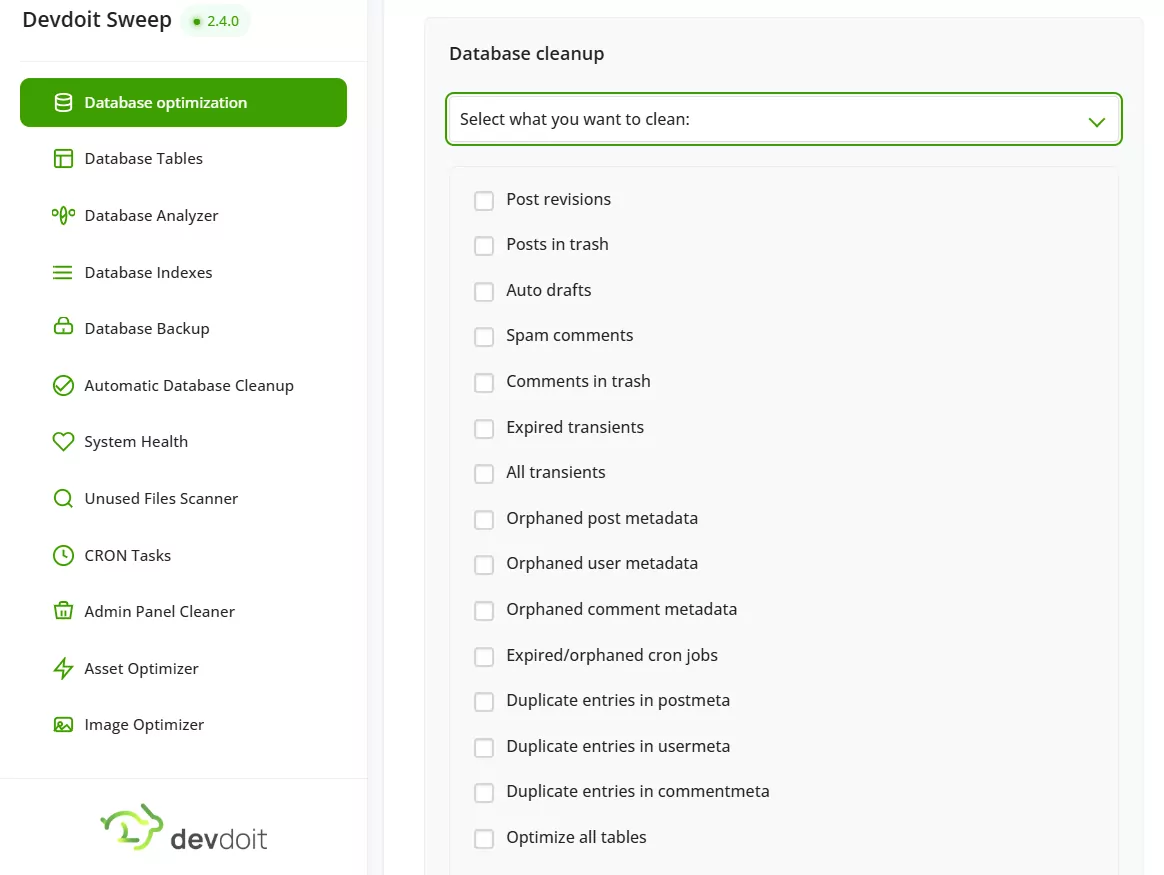
Every website and online store powered by WordPress and WooCommerce uses a database. This is where all entries, products, orders, comments, settings, and user information are saved. Over time, the database grows and—like a computer’s hard drive—it begins to fill up.
Fortunately, there are proven mechanisms that help keep your database in top shape. Regular table analysis and optimization makes your entire website faster, more stable, and more efficient.
What are the benefits of periodic database analysis and optimization?
When your database is organized, WordPress and WooCommerce find the information you need faster. The website opens more efficiently, and the store runs smoothly.
Every extra moment of waiting risks losing a customer. An organized database = shorter load times = satisfied users and a greater chance of completing a purchase.
Site speed is one of the key factors influencing SEO. Regular database optimization prevents your website from slowing down, which helps achieve higher search engine rankings.
An optimized database uses less processing power. This ensures a more stable website, and the website owner doesn’t have to invest in a more expensive server.
Analysis allows you to identify errors and irregularities in your database before they develop into more serious problems. This guarantees smooth website operation and eliminates the risk of sudden outages.
Summary
Regular database analysis and optimization in WordPress and WooCommerce is an investment in:
Your website or online store relies on your database every day. Maintaining it regularly ensures the foundation of your online business.
Over time, WordPress and WooCommerce accumulate a lot of unnecessary data in the database. This makes the site slower, increases the database size, and can even cause errors. Regular cleanup helps maintain fast loading times, reduces server load, and ensures the stability of your online store. Below, we explain what is worth cleaning and the benefits you’ll get.

What it is: WordPress automatically saves every version of a post or page during editing.
Why it clutters: Each change creates a new copy – a post with 10 edits may have dozens of revisions.
Benefits of cleaning: Removing revisions reduces database size and speeds up SQL queries. The editor works faster and smoother.
What it is: Deleted posts and pages moved to the trash but still stored in the database.
Why it clutters: Users often forget to empty the trash, so unnecessary content piles up.
Benefits of cleaning: Permanent deletion reduces database size and makes backups faster.
What it is: Drafts automatically created by WordPress when writing a new post.
Why it clutters: Each time you start writing, a draft is generated—even if you never publish it.
Benefits of cleaning: Removing auto drafts keeps the editor clean and database lighter.
What it is: Comments flagged as spam by WordPress or plugins (e.g., Akismet).
Why it clutters: Bots often flood sites with spam comments.
Benefits of cleaning: Deleting spam reduces database load and speeds up moderation.
What it is: Comments removed by the admin but still sitting in the trash.
Why it clutters: Like posts in trash, they remain until permanently deleted.
Benefits of cleaning: Keeps the comments system efficient and the database lighter.
What it is: Temporary cached data stored by WordPress or plugins (e.g., API calls, widgets).
Why it clutters: Expired transients aren’t always automatically removed.
Benefits of cleaning: Clearing expired transients reduces database size and improves caching efficiency.
What it is: All temporary cached data, active and expired.
Why it clutters: Some plugins create large amounts of transient data that can slow down the site.
Benefits of cleaning: Resetting transients refreshes cache and fixes display issues after updates.
What it is: Extra data linked to posts (e.g., custom fields) with no associated post.
Why it clutters: Created after posts or plugins are deleted.
Benefits of cleaning: A smaller, faster database with fewer unnecessary records.
What it is: Extra data linked to users (e.g., profile settings, plugin data).
Why it clutters: Remains even after a user is deleted.
Benefits of cleaning: Prevents conflicts, reduces errors, and speeds up user management.
What it is: Extra data linked to comments (e.g., votes, plugin info).
Why it clutters: Left behind when comments are deleted.
Benefits of cleaning: Keeps the comments database clean and responsive.
What it is: Scheduled WordPress tasks (e.g., updates, email sending).
Why it clutters: Sometimes tasks remain in the database even if no longer needed.
Benefits of cleaning: Reduces server load and prevents cron-related errors.
What it is: Duplicate rows in the post metadata table.
Why it clutters: Often caused by plugins or repeated data saves.
Benefits of cleaning: Eliminating duplicates speeds up database queries and improves performance.
What it is: Duplicate rows in the user metadata table.
Why it clutters: Caused by buggy plugins or improper saves.
Benefits of cleaning: Faster user management and fewer login/profile errors.
What it is: Duplicate rows in the comment metadata table.
Why it clutters: Caused by comment-related plugins or errors.
Benefits of cleaning: A more efficient comment system and reduced database size.
What it is: A MySQL process that reorganizes and defragments database tables.
Why it clutters: Frequent edits, deletions, and updates leave gaps in tables.
Benefits of cleaning: A compact database, faster SQL queries, and better site performance.
Regularly cleaning your WordPress/WooCommerce database is not just about tidiness—it directly improves site speed, server efficiency, and online store stability. Set a routine cleanup schedule or use optimization plugins to keep your website running at peak performance.